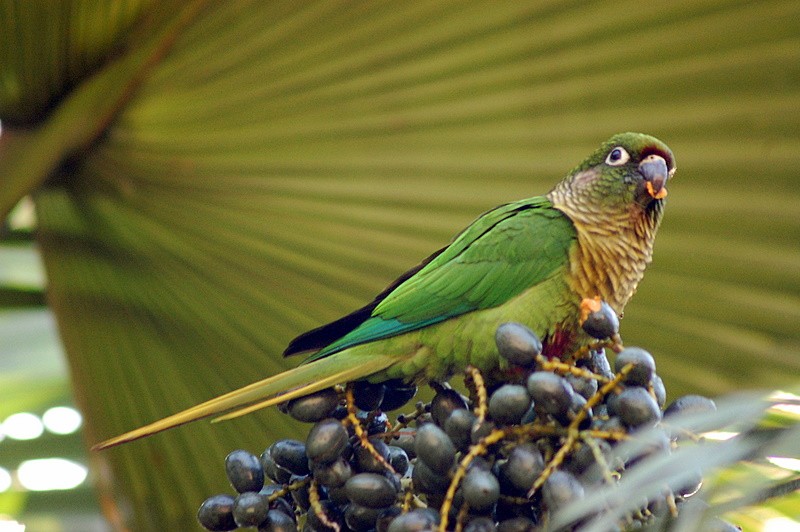Maroon-bellied Parakeet
A species of Lesser Neotropical Parakeets Scientific name : Pyrrhura frontalis Genus : Lesser Neotropical Parakeets
Maroon-bellied Parakeet, A species of Lesser Neotropical Parakeets
Botanical name: Pyrrhura frontalis
Genus: Lesser Neotropical Parakeets
Content
Description People often ask General Info
 Photo By Dario Sanches , used under CC-BY-SA-2.0 /Cropped and compressed from original
Photo By Dario Sanches , used under CC-BY-SA-2.0 /Cropped and compressed from original Description
These birds range from 25 to 28 cm (10–11 in), and are primarily green, with a maroon patch on the belly, a "scaly" yellow-green-barred breast and sides of neck, a whitish ear-patch often tinged brown, and a maroon undertail. The specific name frontalis is a reference to its dark maroon frontlet – a feature which separates it from most similar species. The primaries are blue on the outer webs, green on the inner webs, and dark on the tips. The beak is black. There are two subspecies, with extensive intergradation where their ranges contact: Maroon-bellied parakeet proper, Pyrrhura frontalis frontalis – Brazil from south Bahia to Rio Grande do Sul, and west to Mato Grosso do Sul. Uppertail greenish-yellow grading into a broad reddish tip. Azara's conure, Pyrrhura frontalis chiripepe – Eastern Paraguay, Argentina, Uruguay, and far southern Brazil. Uppertail entirely greenish-yellow. Another subspecies, kriegi, was described from Bahia in 1932, but today it is universally considered a junior synonym of the nominate subspecies. Distinguished by a narrow brownish-red tip to the tail, it constitutes just a morph or an intermediate genotype making up just 20% of the specimens even in the supposed range. The name Krieg's conure is occasionally used in aviculture for such birds, and some breed them exclusively; they are of course perfectly interfertile with individuals of the normal morph however. 
Size
28 cm
Colors
Brown
Green
Yellow
Red
Life Expectancy
25-30 years
Nest Placement
Cavity
Feeding Habits
Maroon-bellied Parakeet primarily feeds on fruits, flowers, and various plant parts. Maroon-bellied Parakeet engage in foraging, typically in the canopy. Their diet includes a wide variety of botanical sources, showing a preference for certain fruits when available. Maroon-bellied Parakeet exhibit adaptations for a frugivorous diet.
Habitat
The maroon-bellied Parakeet is commonly found in habitats ranging from humid montane evergreen forests to lower-lying woodlands, including both moist and drier formations. Preferring forest edges and areas with scattered trees, maroon-bellied Parakeet also adapt to human-altered landscapes such as gallery woodlands, partly cleared zones, and urban parks. These birds are associated with regions where Araucaria trees are present, though this link is not highly strict. Their elevation range extends from sea level to 1400 meters.
Dite type
Herbivorous
People often ask
General Info
Feeding Habits
Bird food type
Species Status
Not globally threatened.